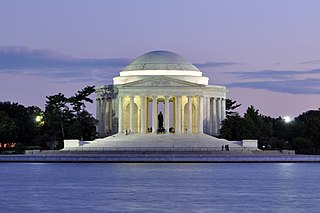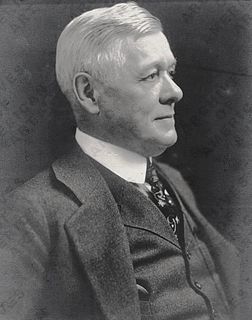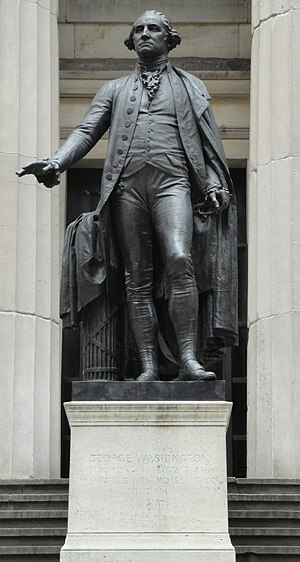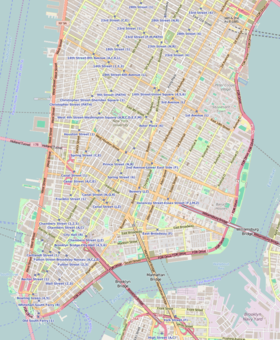
Daniel Chester French, one of the most prolific and acclaimed American sculptors of the late nineteenth and early twentieth centuries, is best known for his design of the monumental statue of Abraham Lincoln (1920) in the Lincoln Memorial, Washington, DC.

The Jefferson Memorial is a presidential memorial built in Washington, D.C. between 1939 and 1943, under the sponsorship of President Franklin D. Roosevelt. For Roosevelt it was a suitable memorial to the Founding Father of the United States, and the founder of the Democratic-Republican Party, Thomas Jefferson.

Federal Hall is the name given to the first of two historic buildings located at 26 Wall Street in the Financial District of Manhattan, New York City. The original, a Federal style structure completed in 1703, served as New York's first City Hall. It was the site where the colonial Stamp Act Congress met to draft its message to King George III claiming entitlement to the same rights as the residents of Britain and protesting "taxation without representation".

Charles Keck was an American sculptor from New York City, New York.

William Ordway Partridge was an American sculptor whose public commissions can be found in New York City and other locations.

James Earle Fraser was an American sculptor during the first half of the 20th century. His work is integral to many of Washington, D.C.'s most iconic structures.

John Quincy Adams Ward was an American sculptor, whose most familiar work is his larger than life-size standing statue of George Washington on the steps of Federal Hall National Memorial in New York City.

Charles Henry Niehaus, was an American sculptor.
George Washington (1732–1799) was the first President of the United States.

The presidential memorials in the United States honor the various Presidents of the United States and seek to perpetuate their legacies.

James Edward Kelly was an American sculptor and illustrator who specialized in depicting people and events of American wars, particularly the American Civil War.

Donald Harcourt De Lue was an American sculptor, best known for his public monuments.

John Massey Rhind was a Scottish-American sculptor. Among Rhind's better known works is the marble statue of Dr. Crawford W. Long located in the National Statuary Hall Collection in Washington D.C. (1926).

Joseph Alexis Bailly was an American sculptor who spent most of his career in Philadelphia, Pennsylvania. He taught briefly at the Pennsylvania Academy of the Fine Arts, which has a collection of his sculpture. His most famous work is the statue of George Washington in front of Independence Hall.

Major General George Henry Thomas, also known as the Thomas Circle Monument, is an equestrian sculpture in Washington, D.C. that honors Civil War general George Henry Thomas. The monument is located in the center of Thomas Circle, on the border of the downtown and Logan Circle neighborhoods. It was sculpted by John Quincy Adams Ward, best known for his work on the George Washington statue. Attendees at the dedication in 1879 included President Rutherford B. Hayes, Generals Irvin McDowell, Philip Sheridan, and William Tecumseh Sherman, senators and thousands of soldiers.

The statue of John Aaron Rawlins, a United States Army general who served during the Civil War and later as Secretary of War, is a focal point of Rawlins Park, a small public park in Washington, D.C.'s Foggy Bottom neighborhood. It was installed in 1874, but relocated several times between 1880 and 1931. The statue was sculpted by French-American artist Joseph A. Bailly, whose best known work is the statue of George Washington in front of Independence Hall in Philadelphia.
















